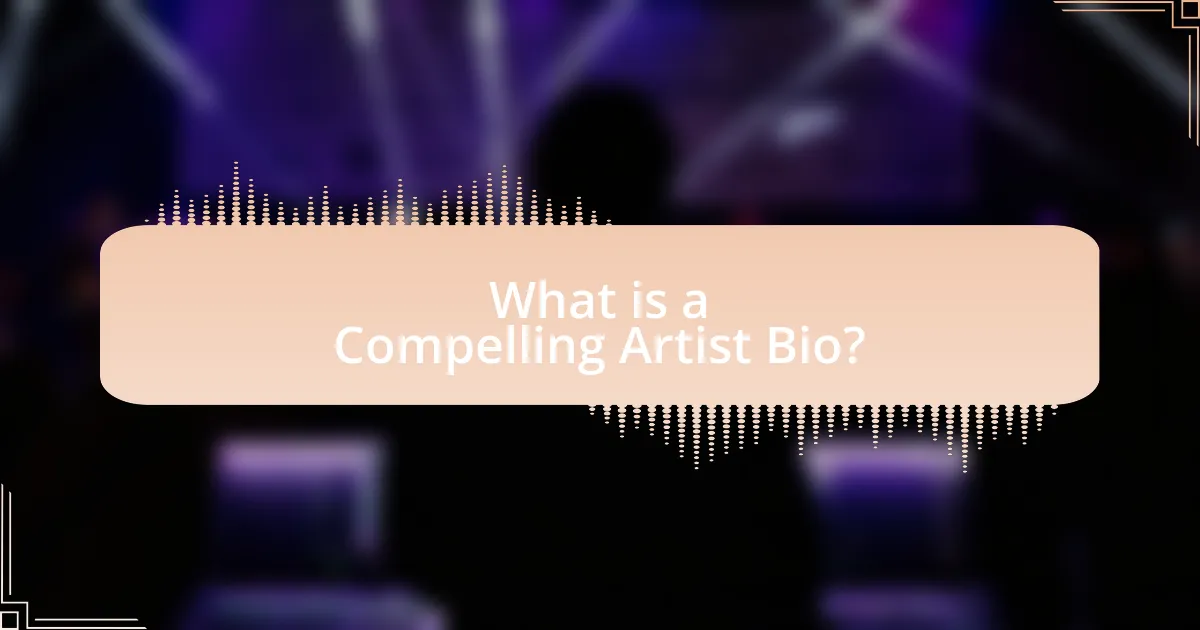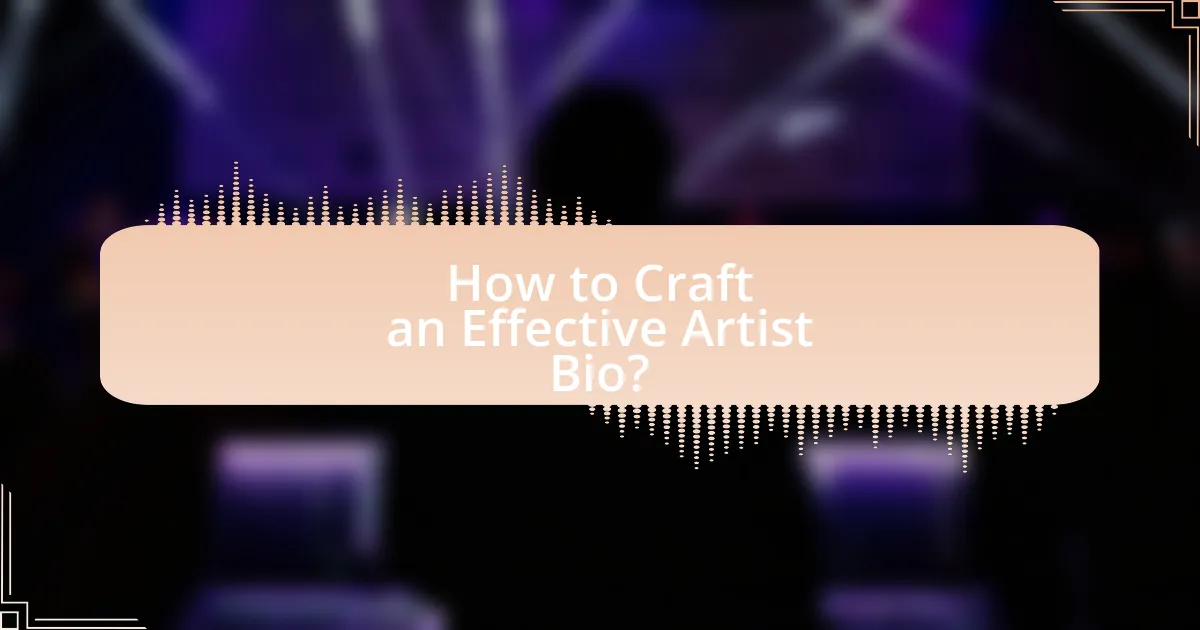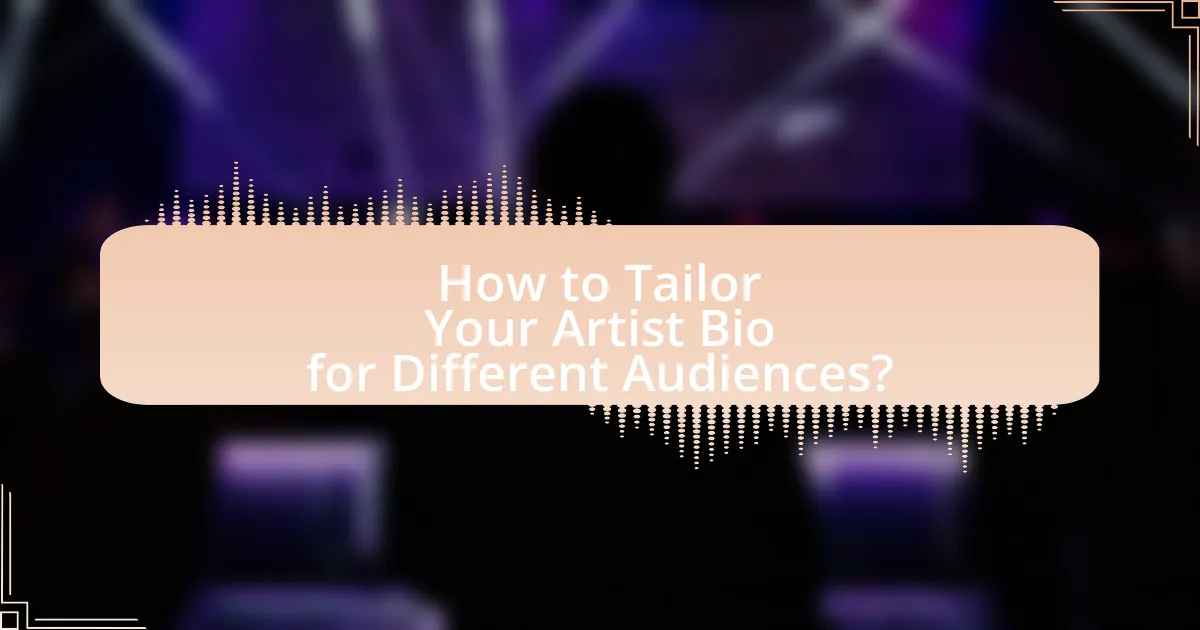A compelling artist bio is a crucial tool for establishing an artist’s identity and enhancing public relations success. This article outlines the essential elements of an effective artist bio, including personal background, artistic influences, and notable achievements, which collectively create a relatable narrative. It emphasizes the importance of clarity, conciseness, and relevance in crafting a bio that resonates with various audiences, including media professionals and art buyers. Additionally, the article provides practical steps for writing and updating an artist bio, highlighting common mistakes to avoid and best practices for maintaining engagement and professionalism.

What is a Compelling Artist Bio?
A compelling artist bio is a concise narrative that effectively communicates an artist’s background, achievements, and artistic vision. This type of bio engages the audience by highlighting key milestones, such as notable exhibitions, awards, and unique influences that shape the artist’s work. For instance, a compelling bio might mention an artist’s participation in prestigious art fairs or collaborations with renowned institutions, thereby establishing credibility and relevance in the art community. The bio should also reflect the artist’s personality and style, making it relatable and memorable to potential viewers and collaborators.
Why is an Artist Bio Important for PR Success?
An artist bio is crucial for PR success because it serves as a foundational tool for establishing an artist’s identity and narrative. A well-crafted bio communicates the artist’s background, achievements, and unique style, which helps media outlets, promoters, and fans understand and connect with the artist. For instance, a study by the Music Industry Research Association found that 70% of music journalists consider an artist’s bio essential for writing features or reviews. This statistic underscores the importance of a compelling bio in gaining media attention and fostering relationships within the industry.
How does an Artist Bio impact public perception?
An artist bio significantly impacts public perception by shaping how audiences and industry professionals view the artist’s identity, credibility, and artistic narrative. A well-crafted bio provides essential context about the artist’s background, influences, and achievements, which can enhance their relatability and appeal. For instance, research indicates that 70% of art buyers consider an artist’s biography when making purchasing decisions, highlighting the bio’s role in influencing consumer behavior and perceptions. Furthermore, a compelling bio can establish an artist’s authority in their field, as seen in cases where artists with detailed bios showcasing their education and exhibitions receive more media attention and opportunities.
What role does an Artist Bio play in media outreach?
An Artist Bio serves as a crucial tool in media outreach by providing a concise and engaging summary of an artist’s background, achievements, and artistic vision. This bio helps media professionals quickly understand the artist’s identity and relevance, facilitating informed coverage and promotion. For instance, a well-crafted Artist Bio can highlight notable exhibitions, awards, or collaborations, which can attract media interest and enhance the artist’s visibility in a competitive landscape.
What Elements Make an Artist Bio Compelling?
A compelling artist bio includes personal background, artistic influences, achievements, and a unique narrative. Personal background provides context about the artist’s origins and experiences, which helps to humanize them. Artistic influences highlight the sources of inspiration that shape their work, allowing audiences to connect on a deeper level. Achievements, such as exhibitions, awards, or notable collaborations, establish credibility and demonstrate the artist’s impact in the field. A unique narrative weaves these elements together, creating a memorable story that resonates with the audience. This combination engages readers and fosters a connection, making the bio effective for public relations and promotional purposes.
What key information should be included in an Artist Bio?
An Artist Bio should include the artist’s name, artistic background, notable achievements, and a brief description of their artistic style or medium. The artist’s name establishes their identity, while the artistic background provides context about their education and influences. Notable achievements, such as awards or exhibitions, highlight their credibility and recognition in the art community. A description of their artistic style or medium offers insight into their creative process and thematic focus, helping audiences understand their work better. This structured information allows for a comprehensive understanding of the artist’s professional profile.
How can storytelling enhance an Artist Bio?
Storytelling can enhance an Artist Bio by creating a deeper emotional connection with the audience. This connection is crucial as it allows potential fans, galleries, and collaborators to understand the artist’s journey, motivations, and unique perspective. For instance, a bio that includes personal anecdotes or pivotal moments in the artist’s life can make their work more relatable and memorable. Research indicates that narratives can increase engagement and retention of information, as people are more likely to remember stories than mere facts. Therefore, incorporating storytelling elements into an Artist Bio not only humanizes the artist but also makes their work more impactful and accessible to the audience.

How to Craft an Effective Artist Bio?
To craft an effective artist bio, focus on clarity, conciseness, and relevance to your artistic identity. Begin with a strong opening that includes your name, artistic medium, and a brief overview of your work. Follow this with key achievements, such as exhibitions, awards, or notable collaborations, to establish credibility. Incorporate personal elements that reflect your artistic journey, influences, and unique perspective, as these details engage the reader and create a connection.
For instance, a well-structured bio might highlight your education, significant projects, and the themes you explore in your art. According to the National Endowment for the Arts, artist bios that effectively communicate personal narratives alongside professional accomplishments resonate more with audiences and potential collaborators. This approach not only showcases your skills but also humanizes your work, making it more relatable and memorable.
What Steps Should You Follow to Write an Artist Bio?
To write an artist bio, follow these steps: first, introduce yourself with your name and artistic medium. Next, provide a brief overview of your background, including education and relevant experiences that shaped your artistic journey. Then, highlight key achievements, such as exhibitions, awards, or notable collaborations, to establish credibility. After that, describe your artistic style and themes, explaining what influences your work and what you aim to convey. Finally, conclude with your current projects or future aspirations to give readers insight into your ongoing artistic development. This structured approach ensures clarity and engages the audience effectively.
How do you identify your unique artistic voice?
To identify your unique artistic voice, engage in self-reflection and experimentation with various styles and mediums. This process allows you to discover what resonates with you personally and what themes or messages you are passionate about conveying. Research indicates that artists who actively explore different techniques and influences are more likely to develop a distinctive voice, as seen in studies on creative development by researchers like Mihaly Csikszentmihalyi. By analyzing your influences and consistently creating, you can refine your artistic identity, leading to a clearer expression of your individuality in your work.
What format should you use for your Artist Bio?
The format for your Artist Bio should be concise and structured, typically consisting of a brief introduction, a summary of artistic achievements, and personal background information. This structure allows for clarity and engagement, making it easier for readers to grasp essential details quickly. A well-crafted Artist Bio often includes specific elements such as notable exhibitions, awards, and influences, which provide context and credibility to the artist’s work.
What Common Mistakes Should Be Avoided in an Artist Bio?
Common mistakes to avoid in an artist bio include excessive jargon, lack of focus, and failure to highlight achievements. Excessive jargon can alienate readers who may not be familiar with specific terms, making the bio less accessible. A lack of focus can lead to a disorganized narrative that fails to convey the artist’s unique identity and purpose. Additionally, not highlighting significant achievements, such as exhibitions or awards, can diminish the bio’s impact and credibility. These elements are crucial for creating a compelling narrative that resonates with audiences and enhances PR success.
How can vague language undermine your Artist Bio?
Vague language can undermine your Artist Bio by failing to convey your unique identity and artistic vision clearly. When an Artist Bio lacks specificity, it becomes difficult for audiences, including potential fans and industry professionals, to understand what sets you apart from others. For instance, using general terms like “creative” or “passionate” does not provide insight into your specific style, influences, or achievements. This lack of clarity can lead to disinterest or confusion, ultimately diminishing your chances of engaging your target audience effectively.
Why is it important to avoid clichés in your Artist Bio?
Avoiding clichés in your Artist Bio is crucial because they dilute your unique identity and fail to engage your audience. Clichés make your bio sound generic and unoriginal, which can lead to a lack of interest from potential fans, collaborators, or industry professionals. Research indicates that personalized narratives resonate more effectively with audiences, as they create a stronger emotional connection. For instance, a study published in the Journal of Marketing found that unique storytelling significantly enhances audience engagement and retention. Therefore, crafting a distinctive and authentic bio is essential for standing out in a competitive artistic landscape.

How to Tailor Your Artist Bio for Different Audiences?
To tailor your artist bio for different audiences, identify the specific interests and values of each audience segment. For example, when addressing industry professionals, emphasize your achievements, collaborations, and technical skills, as they seek credibility and marketability. Conversely, when writing for fans, focus on your personal story, artistic journey, and emotional connection to your work, as this fosters relatability and engagement. Research shows that personalized communication increases audience connection, with studies indicating that tailored messaging can improve engagement rates by up to 50%.
What Adjustments Should You Make for Media Outlets?
To effectively engage media outlets, you should tailor your artist bio to highlight key achievements and relevant experiences that resonate with their audience. This includes emphasizing notable performances, awards, and collaborations that align with the outlet’s focus, whether it be music, art, or culture. For instance, if targeting a music publication, include chart rankings or festival appearances that demonstrate your impact in the industry. Additionally, ensure the bio is concise and compelling, ideally under 300 words, to maintain the attention of busy editors. Research shows that media professionals prefer bios that are straightforward and informative, allowing them to quickly assess the artist’s relevance to their content.
How can you align your Artist Bio with the publication’s tone?
To align your Artist Bio with the publication’s tone, analyze the publication’s style and language to ensure consistency. This involves identifying key characteristics such as formality, vocabulary, and thematic focus. For instance, if the publication uses a conversational tone, your bio should reflect that by incorporating informal language and personal anecdotes. Conversely, if the publication maintains a professional and formal tone, your bio should adopt a more structured and polished approach. Research shows that tailored communication increases engagement, as demonstrated by a study from the Journal of Communication, which found that audiences respond more positively to content that matches their expectations.
What specific details should you emphasize for journalists?
You should emphasize key achievements, unique artistic style, and relevant background information for journalists. Highlighting specific awards, notable exhibitions, or collaborations establishes credibility and interest. Additionally, detailing your artistic influences and the themes in your work provides context that journalists can use to engage their audience. For instance, mentioning a recent award from a prestigious organization or a feature in a well-known gallery can serve as concrete proof of your impact in the art world.
How to Update Your Artist Bio Over Time?
To update your artist bio over time, regularly assess and revise it to reflect your latest achievements, influences, and artistic direction. This process involves incorporating new projects, exhibitions, collaborations, or awards that enhance your professional narrative. For instance, if you release a new album or participate in a significant art show, these milestones should be added to keep your bio current and relevant. Additionally, consider the evolving language and tone that resonate with your audience; adapting your bio to reflect contemporary trends can enhance engagement. Regular updates ensure that your bio accurately represents your artistic journey and maintains its effectiveness in public relations efforts.
When should you revise your Artist Bio?
You should revise your Artist Bio whenever there are significant changes in your career, such as new exhibitions, awards, or collaborations. Regular updates ensure that your bio accurately reflects your current artistic journey and achievements. For instance, if you have participated in a major exhibition or received an award, including this information enhances your credibility and relevance in the art community. Additionally, revising your bio every few years can help maintain its freshness and alignment with your evolving artistic identity.
What new achievements should be highlighted in updates?
New achievements that should be highlighted in updates include recent awards, notable exhibitions, and significant collaborations. For instance, winning a prestigious art award can enhance an artist’s credibility and visibility in the industry. Additionally, showcasing participation in high-profile exhibitions, such as those at renowned galleries or art fairs, demonstrates an artist’s recognition and relevance in the art community. Collaborations with other artists or brands can also indicate innovation and versatility, appealing to a broader audience. These achievements collectively strengthen an artist’s bio and enhance their public relations efforts.
What Are Best Practices for a Compelling Artist Bio?
A compelling artist bio should be concise, engaging, and informative, effectively showcasing the artist’s background, achievements, and unique style. To achieve this, artists should start with a strong opening statement that captures attention, followed by relevant details such as education, notable exhibitions, awards, and influences. Including personal anecdotes or insights can add depth and relatability.
For instance, a study by the National Endowment for the Arts highlights that artist bios that include specific achievements and personal narratives tend to resonate more with audiences, enhancing engagement and interest. Additionally, maintaining a professional tone while infusing personality can help the bio stand out in a crowded market.
How can you ensure your Artist Bio remains engaging and relevant?
To ensure your Artist Bio remains engaging and relevant, regularly update it with new achievements, projects, and influences. This practice keeps the content fresh and reflects your current artistic journey, which is crucial for maintaining audience interest. For instance, incorporating recent exhibitions, collaborations, or awards can highlight your growth and adaptability in the evolving art landscape. Additionally, using a narrative style that connects emotionally with readers can enhance engagement, as studies show that storytelling increases retention and relatability in bios.
What tips can help you maintain a professional tone in your Artist Bio?
To maintain a professional tone in your Artist Bio, focus on clarity, conciseness, and relevant achievements. Clear language ensures that your message is easily understood, while conciseness keeps the bio engaging and to the point. Highlighting relevant achievements, such as exhibitions, awards, or collaborations, adds credibility and showcases your expertise. Using a formal writing style, avoiding slang, and maintaining a consistent voice throughout the bio further reinforce professionalism.